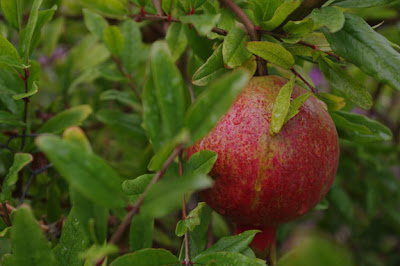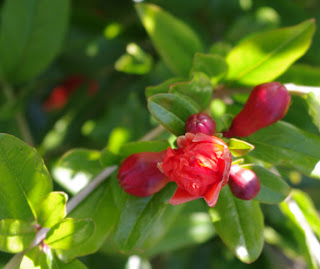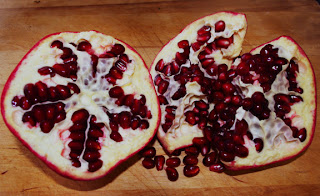Living in California I definitely take Pomegranates for granted. We can grow them here and they are pretty common. Every nursery around here carries them. I’ve even used them in planting plans on model homes for developers.
In the late spring and early summer the small, multi-branched tree becomes covered in these bright red flowers and buds. Contrasting the bright green foliage it not only makes a wonderful fruit tree but it also is quite ornamental. Late fall brings the fruit, which will split when they become overripe. The trick is to pick them before they split, though I haven’t quite figured out when that is. They will start to develop small fissures, so if you pick before those fissures open up it should be perfectly sweet and tart.
The best way to open up a pomegranate is to score the outside along the center and then pry it open. This reduces the mess because you avoid cutting the seeds, which can easily stain everything they touch, including our fingers. Eating pomegranates is definitely a labor of love. You have to carefully pry the seeds out from between the pithy flesh and remove the white membranes from around each chamber. I’ve heard of several different ways to do this, from doing it underwater to striking the outside of the fruit with a rubber mallet. I haven’t tried either of these techniques though.
So now you want to grow a pomegranate tree? Well, their main requirement is 150 hours of chill and heat during the summer. They grow well in the southern states and in California. They can also be grown in the Pacific Northwest, thought crops will be small due to the lack of heat. They do best in Zones 8 to 10 (though some varieties can be grown in Zone 7), though there are dwarf varieties such as Red Silk that can be planted in a pot and brought indoors during the winter.
If you’ve never tried a pomegranate (and no, pomegranate juice does not count as it tastes nothing like pomegranates), it is definitely something you should try to find. The taste is bright, tart and sweet.





I love pomegranates, and always love to sprinkle the seeds over a spinach salad during the holidays, as they look rather festive. I've avoided planting one though because of the splitting issues.
I'm jealous – they won't grow in SF, now matter how hard I wish they would!
I have a bunch of poms I got at the farmer's market, however, and will be making pomegranate syrup (which is heavenly on sourdough pancakes and waffles, by the way) later tonight.
re: seed dislodgement…I can attest to the hitting-with-mallet technique, though I don't see why anyone would use anything other than the back of their hand. Works just fine.
I am going to try to score some different varieties of pomegranate at the scion exchange in January. I inherited a pom w/ the house, but it is just not happy. I watered and topped and fertilized it the first year, and the blooms were just stunning. And then the fruit was small and every last pom split as it ripened.
This year I didn't do a thing other than keep the coop litter nearby, covered with a tarp. It was watered by the rains, chilled by the freezing temps, etc. Lots and lots of fruit, and I have probably 5 lbs of faintly under ripe arils in the freezer, but much of the fruit split again. The chickens were really good pomegranate disposal machines when the remaining fruits started falling off the tree.
Dunno. I might do some cuttings and root them elsewhere, but this variety is not really to yodel for.
Sara, all poms will split if they stay on the tree too long. They have a tendency to mostly all ripen at once (at least in my experience), so if you see one start to split pick all of them right away.